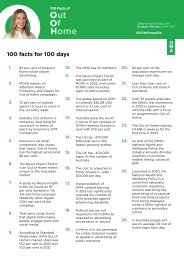THE ART AND SCIENCE OF LOOKING UP REPORT
Create successful ePaper yourself
Turn your PDF publications into a flip-book with our unique Google optimized e-Paper software.
Building New Brain<br />
The Work in Progress of Neurogenesis<br />
Gone are the days when we thought our brain was set after a few years, and we<br />
couldn’t change it. We now know that the brain moves, grows, prunes and changes<br />
continually in response to external and internal stimuli.<br />
In short we sculpt our brain depending on what we<br />
reinforce and pay attention to.<br />
There are peak times in life such as early childhood and<br />
adolescence during which the brain grows in size and<br />
complexity, but under the right conditions we can grow<br />
new brain at any stage of our lives. The ways to do<br />
this include adequate exercise and sleep, learning new<br />
things, eating the right foods to keep our microbiome<br />
healthy, and last but not least, direct human interaction.<br />
Due to the chemical cocktail we create when we connect,<br />
not only do we light up each other’s brains but we each<br />
possess the power to rewire both our own brains and<br />
those of the people we interact with. It is like an in-built<br />
super power that we are hardly aware of, but we see<br />
and feel the results.<br />
As we synchronise and resonate, we start<br />
chemicals flowing, sparking into action<br />
the neurons and dendrites that connect up,<br />
shape and differentiate our brain.<br />
One of the results of this is to stimulate<br />
various systems that literally create<br />
new brain in both our own and someone<br />
else’s brain simply by interacting in<br />
certain positive ways.<br />
Changes in positive affect can help to heal us when<br />
we’re sick, face the unknown with courage<br />
and compassion, 16 and come up with new ideas,<br />
new solutions, and new ways of doing things.<br />
Change happens when the interaction is negative too,<br />
often with longstanding results. Boyatzis et al. studied<br />
the brains of those who had either resonant or<br />
dissonant leaders while they recalled the experience,<br />
often years later. The brains of those with resonant<br />
leaders activated areas associated with mirror neurons,<br />
the default mode and social and affective networks,<br />
while those with dissonant leaders showed a pattern<br />
of quite different mirror neurons – avoidance, narrowed<br />
attention, decreased compassion and negative affect.<br />
Neural activation between people takes many forms, depending on the nature of our interaction.<br />
Figure 6.0<br />
A Quick Glance<br />
lights up neurons in specific<br />
parts of our brain with direct<br />
gaze, automatically evoking a<br />
positive affective (emotional)<br />
reaction. 17<br />
41<br />
Ongoing Gaze<br />
has advantageous effects<br />
on things like memory,<br />
pro-social behaviour, and<br />
individual perception. 18<br />
More Intense Engagement<br />
such as collaborating,<br />
storytelling or sharing jokes,<br />
makes chemical changes<br />
that create deeper and wider<br />
connections and changes,<br />
many of which are long term.<br />
Due to the chemical cocktail we create when we<br />
connect, not only do we light up each other’s brains<br />
but we each possess the power to rewire both our<br />
own brains and those of the people we interact with.<br />
It is like an in-built super power that we are hardly<br />
aware of, but we see and feel the results.<br />
42















